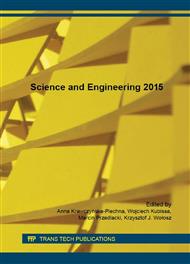[1]
R. Jaskulski, Influence of selected calculation assumptions on the safety margin of bent and compressed reinforced concrete rod elements, determined using Monte Carlo method, (in Polish), PhD thesis, Warsaw University of Technology, Płock, (2005).
Google Scholar
[2]
P. Wiliński, Load capacity of reinforced high strength concrete columns, (in Polish), PhD thesis, Warsaw University of Technology, Płock, (2004).
Google Scholar
[3]
A.J. Sobey, J.I.R. Blake, R.A. Shenoi, Monte Carlo reliability analysis of tophat stiffened composite plate structures under out of plane loading, Reliability Engineering & System Safety, vol. 110, 2013, pp.41-49.
DOI: 10.1016/j.ress.2012.08.011
Google Scholar
[4]
D.L. Kozak, A.B. Liel, Reliability of steel roof structures under snow loads, Structural Safety, vol. 54, 2015, pp.46-56.
DOI: 10.1016/j.strusafe.2015.02.004
Google Scholar
[5]
B. Gaspar, C. Guedes Soares, Hull girder reliability using a Monte Carlo based simulation method, Probabilistic Engineering Mechanics, vol. 31, 2013, pp.65-75.
DOI: 10.1016/j.probengmech.2012.10.002
Google Scholar
[6]
J. Pawlikowski, Basis of probabilistic design of concrete structures, (in Polish), ITB, Warsaw, (2004).
Google Scholar
[7]
T. Godycki-Ćwirko, Concrete mechanics, (in Polish), Arkady, Warsaw, (1982).
Google Scholar
[8]
J. Kobiak, W. Stachurski, Reinforced concrete structures, vol. I, Arkady, Warsaw, (1995).
Google Scholar
[9]
W. Kukulski (Ed. ) et al., Calculation of reinforced and pre-stressed concrete structures with the limit states method according to PN-76/B-03264, (in Polish), Arkady, Warsaw, (1976).
Google Scholar
[10]
A. Ajdukiewicz (Ed. ) et al., Eurocode 2. Handy abstract for construction engineers, SPC, Cracow, (2009).
Google Scholar
[11]
M. Knauf (Ed. ) et al., Basis of design of concrete reinforced and pre-stressed structures according to Eurocode 2, (in Polish), DWE, Wrocław, (2006).
Google Scholar
[12]
B. Lewicki (Ed. ) et al., Concrete, reinforced concrete and pre-stressed concrete structures. Scientific comment to Polish standard PN-B-03264: 2002 (in Polish), vol. I, ITB, Warsaw (2005).
Google Scholar
[13]
A. Łapko, B.C. Jensen, Basis of design and algorithms for the calculation of reinforced concrete structures, (in Polish), Arkady, Warsaw, (2005).
Google Scholar
[14]
F. Casciati, I. Negri, R. Rackwitz, Geometrical Variability in Structural Members and Systems, JCSS Working Document, (1991).
Google Scholar
[15]
General Principles on the Specification on Safety Requirements for Structures, German Institute for Standardisation DIN, Beuth (1981).
Google Scholar
[16]
J. Pawlikowski, P. Wiliński, R. Jaskulski: A new probability density distribution for statistical interpretation of test results, (in Polish), Inżynieria i Budownictwo, 9 (2005): 496-499.
Google Scholar
[17]
[Spr2010] R. Jaskulski, P. Wiliński, Probabilistic analysis of safety margin of reinforced concrete elements subjected to torsion, The report of the statutory research No. 504G/7701/0260/001, (in Polish, unpublished), Warsaw University of Technology, Płock, (2010).
Google Scholar


